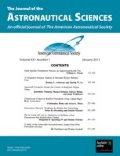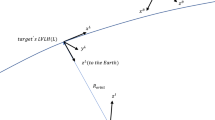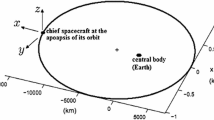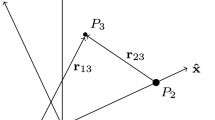Abstract
This paper addresses a feed-forward optimal control problem for one rigid body to approach to and align with another arbitrarily rotating rigid body, with an application to the satellite rendezvous problem. In particular, we focus on the satellite rendezvous strategy of finding an optimal trajectory, and the required thrust force profiles, which will guide the chasing spacecraft to approach the tumbling satellite such that the two vehicles will eventually have no relative rotation and thus a subsequent docking or capture operation can be safely performed with a normal docking or capture mechanism. Our approach is to model the system using rigid-body dynamics and apply Pontryagin’s Maximum Principle for the optimal control. A planar problem is presented as a case study, in which together with the Maximum Principle, the Lie algebras associated with the system are used to examine the existence of singular extremals for the time-optimal control problem. Also, optimal trajectories and the corresponding set of control force/torque profiles are numerically generated for the time/fuel-consumption optimal control problem.
Similar content being viewed by others
References
KASAI, T., ODA, M., and SUZUKI, T. “Results of the ETS-7 Mission-Rendezvous Docking and Space Robotics Experiment,” Proceedings of the Fifth International Symposium on Artificial Intelligence, Robotics and Automation in Space, ESTEC/ESA, Nordwijk, The Netherlands, 1999, pp. 299–306.
BRAUKUS, M. and NEWTON, K. “On Orbit Anomaly Ends DART Mission Early,” http://www.nasa.gov/mission_pages/dart/media/05-051.html, April 2005.
WHELAN, D. A., ADLER, E. A., WILSON, S. B., and ROESLER, G. “DARPA Orbital Express program: Effecting a Revolution in Space-Based Systems,” Proceedings of SPIE-The International Society for Orbital Engineering, Vol. 4136, 2000, pp. 48–56.
SETH, D. P. “Orbital Express: Leading the Way to a New Space Architecture,” 2002 Space Core Tech Conference, Colorado Springs, November 19–21, 2002.
BOSSE, A. B. et al. “SUMO: Spacecraft for Universal Modification of Orbits,” SPIE Defence and Security Symposium, Orlando, FL, April 2004, Proceedings of SPIE, Vol. 5419, pp. 36–46.
SOMMER, B. “Automation and Robotics in the German Space Program-Unmanned on-Orbit Servicing (OOS) & the TECSAS Mission,” Proceedings of 55th IAF International Astronautical Congress, Vancouver, Canada, October 4–8, 2004, Paper # IAC-04-IAA.3.6.2.03.
DUPRIS, E., DOYON, M., MARTIN, E., ALLARD, P., PIEDBOEUF, J. C., and MA, O. “Autonomous Operations for Space Robots,” Proceedings of the 55th Int. Astronautical Congress, October 2004, Paper #IAC-04-IAA.U.5.03.
MATSUMOTO, S., OHKAMI, Y., WAKABAYASHI, Y., ODA, M., and H. UENO “Satellite Capturing Strategy Using Agile Orbital Servicing Vehicle, Hyper-OSV,” Proceedings of the IEEE 2002 International Conference on Robotics and Automation, Washington DC, May 2002, pp. 2309–2314.
YOSHIDA, K., NAKANISHI, H., UENO, H., INABA, N., NISHIMAKI, T., and M. ODA “Dynamics and Control for Robotic Capture of a Non-Cooperative Satellite,” Proceedings of the 7th International Symposium on Artificial Intelligence and Automation in Space, Nara, Japan, 2003.
SAKAWA, Y. “Trajectory Planning of a Free-Flying Robot by Using the Optimal Control,” Optimal Control Applications and Methods, Vol. 20, 1999, pp. 235–248.
MATSUMOTO, S., JACOBSEN, S., DUBOWSKY, S., and OHKAMI, Y. “Approach Planning and Guidance for Uncontrolled Rotating Satellite Capture Considering Collision Avoidance,” Proceedings of the 7th International Symposium on Artificial Intelligence and Automation in Space, Nara, Japan, 2003.
NAKASUKA, S. and FUJIWARA, T. “New Method of Capturing Tumbling Object in Space and its Control Aspects,” Proceedings of the IEEE International Conference on Robotics and Automation, Hawaii, USA, August 1999, pp. 973–978.
FITZ-COY, N. and LIU, M. C. “Modified Proportional Navigation Scheme for Rendezvous and Docking with Tumbling Targets: the Planar Case,” Proceedings of the Symposium on Flight Mechanics/Estimation Theory, NASA/GSFC, Maryland, May 16–18, 1995, pp. 243–252.
PONTRYAGIN, L. S., BOLTYANSKII, V. G., GAMKRELIDZE, R.V., and MISHCHENKO, E. F. “The Mathematical Theory of Optimal Processes,” (translated by D. E. Brown), Macmillan Company, 1964.
SONTAG, E.D. and SUSSMANN, H. J. “Time-Optimal Control of Manipulators,” Proceedings of the IEEE International Conference on Robotics and Automation, 1986.
SAKAWA, Y. and SHINDO, Y. “Optimal Control of Container Cranes,” Automatica, Vol. 18, 1980, pp. 257–266.
CHYBA, M., LEONARD, N. E., and SONTAG, E.D. “Time-Optimal Control for Underwater Vehicles,” Proceedings of the IFAC Workshop on Lagrangian and Hamiltonian Methods for Nonlinear Control, 2000.
JADDU, H. and VLACH, M. “Successive Approximation Method for Non-Linear Optimal Control Problems with Application to a Container Crane Problem,” Optimal Control Applications and Methods, Vol. 23, 2002, pp. 275–288.
BETTS, J. T. “Survey of Numerical Methods for Trajectory Optimization,” Journal of Guidance, Control and Dynamics, Vol. 21, No. 2, 1998, pp. 193–207.
FEHSE, W. Automated Rendezvous and Docking of Spacecraft, Cambridge University Press, 2003.
NIJMEIJER, H. and A. VAN DER SCHAFT, Nonlinear Dynamical Control Systems, (Third Edition), Springer-Verlag, 1990.
GELLER, D.K. “Orbital Rendezvous: When is Autonomy Required,” Journal of Guidance, Control, and Dynamics, Vol. 30, No. 4, 2007.
Author information
Authors and Affiliations
Additional information
A shortened version of this paper was published in the Proceedings of the 2006 IEEE International Conference on Intelligent Robots and Systems, October 9–15, 2006, Beijing, pp. 4109–4114.
Rights and permissions
About this article
Cite this article
Ma, Z., Ma, O. & Shashikanth, B.N. Optimal approach to and alignment with a rotating rigid body for capture. J of Astronaut Sci 55, 407–419 (2007). https://doi.org/10.1007/BF03256532
Published:
Issue Date:
DOI: https://doi.org/10.1007/BF03256532




